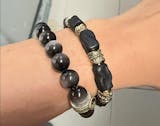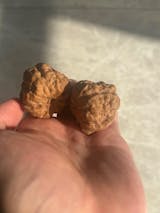How Tibetan People Use Healing Crystals for Meditation
Introduction
Tibet is often referred to as the "Roof of the World," and its spiritual traditions are as elevated as its geography. Tibetan Buddhism, deeply rooted in meditation and spirituality, has long incorporated healing crystals into its practices.Today we'll discuss how Tibetan people use healing crystals for meditation.

The Significance of Crystals in Tibetan Culture
In Tibetan culture, healing crystals are considered sacred objects imbued with spiritual energy. These stones are believed to carry the vibrations of the Earth and the cosmos, making them potent tools for spiritual practices. Tibetan Buddhism teaches that everything in the universe is interconnected, and crystals serve as a bridge between the physical and spiritual worlds.
Crystals such as turquoise, quartz, and lapis lazuli hold particular importance in Tibetan traditions. Turquoise, for example, is seen as a symbol of the sky and water, representing the balance of male and female energies. Lapis lazuli is valued for its deep blue color, which is associated with the Third Eye chakra, enhancing intuition and spiritual insight. Quartz, often used in Tibetan prayer beads (mala beads), is believed to amplify energy and intentions, making it a powerful stone for meditation.

Healing Crystals Used in Tibetan Meditation
Tibetans use a variety of crystals in their meditation practices, each with its unique properties and significance. Here are some of the most commonly used crystals in Tibetan meditation:
1.Turquoise
As mentioned earlier, turquoise is a highly revered stone in Tibetan culture. It is often used in malas or worn as jewelry to provide protection and bring good fortune. During meditation, turquoise is believed to help balance the body's energies, calm the mind, and enhance communication with the spiritual world. Its soothing energy is also thought to alleviate stress and anxiety, promoting a deeper, more peaceful meditation experience.
2.Lapis Lazuli
Lapis lazuli is another powerful stone used in Tibetan meditation. Known for its deep blue color with golden flecks, lapis lazuli is associated with the Third Eye chakra, which governs intuition and spiritual awareness. Tibetan meditators use lapis lazuli to enhance their psychic abilities, deepen their meditation, and connect with their higher selves. The stone's energy is believed to open the mind to higher knowledge and wisdom, making it a valuable tool for spiritual growth.
3.Clear Quartz
Clear quartz is a versatile crystal widely used in Tibetan spiritual practices. It is often incorporated into prayer beads or placed on altars during meditation. Clear quartz is known as a "master healer" because it can amplify the energy of other crystals and intentions. In Tibetan meditation, clear quartz is used to focus the mind, enhance concentration, and align the chakras. Its purifying energy is also believed to cleanse the aura and protect against negative influences.
4.Carnelian
While not as commonly known, carnelian is another crystal used by Tibetan meditators. Carnelian is associated with the sacral chakra, which governs creativity, vitality, and emotional balance. Tibetans use carnelian during meditation to ground themselves, boost their energy levels, and overcome lethargy. The stone’s warm, invigorating energy helps to awaken the mind and spirit, making it easier to maintain focus during meditation.
5.Mala Beads
Mala beads, often made from various crystals or semi-precious stones, play a significant role in Tibetan meditation. A mala typically consists of 108 beads, each representing a prayer or mantra recited during meditation. The beads help the practitioner maintain concentration and rhythm while chanting. Crystals like turquoise, quartz, or sandalwood are often used in malas to infuse the meditation with specific energies, such as healing, clarity, or protection.

Meditation Techniques with Healing Crystals
Tibetan meditation with healing crystals involves several techniques designed to harness the crystals’ energy. Here are a few methods commonly practiced:
1.Mantra Meditation with Mala Beads: One of the most common methods is using mala beads during mantra meditation. The practitioner recites a specific mantra, such as "Om Mani Padme Hum," while counting each bead on the mala. This technique not only helps maintain focus but also allows the crystal beads to impart their healing energy with each repetition.
2.Crystal Placement: Another technique involves placing crystals on or around the body during meditation. For example, placing a turquoise stone on the throat chakra can enhance communication and self-expression, while a piece of lapis lazuli on the forehead can stimulate the Third Eye chakra. This placement helps to align and balance the chakras, leading to a more profound meditative experience.
3.Visualization: Tibetans also use crystals in visualization techniques. During meditation, the practitioner visualizes the crystal's energy merging with their own, cleansing their aura, and opening their chakras. This practice enhances the healing effects of the crystal and deepens the meditative state.

Conclusion
For Tibetan practitioners, healing crystals transcend mere adornment, serving as sacred instruments in their spiritual journey. These crystals are revered not only for their beauty but for their profound ability to connect individuals with the vast energies of the cosmos. In Tibetan Buddhism, the mindful integration of these stones into meditation rituals embodies a deep respect for the interconnectedness of all existence..The use of healing crystals in Tibetan meditation reflects a profound reverence for the traditions and wisdom that have shaped their rich spiritual heritage.
Related articles:
Why Tibetan People Love Adorning Themselves with Jewelry
Where is Tibet and Why is Tibet the Sacred Land in Our Hearts?
Explore the Rich Diversity of Tibetan Bracelets

























































